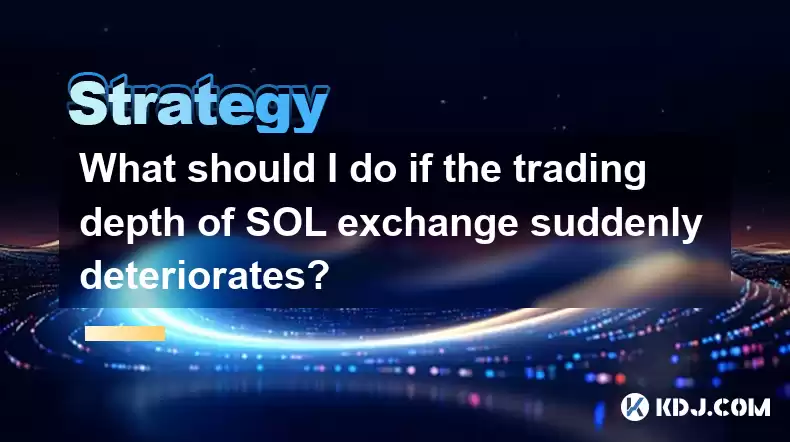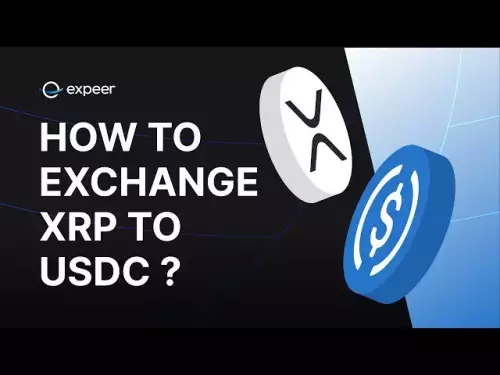-
 bitcoin
bitcoin $112715.707551 USD
-1.71% -
 ethereum
ethereum $4101.475385 USD
-3.01% -
 tether
tether $1.000644 USD
-0.02% -
 bnb
bnb $1207.619465 USD
-6.77% -
 xrp
xrp $2.501451 USD
-3.98% -
 solana
solana $202.947124 USD
-3.32% -
 usd-coin
usd-coin $1.000295 USD
0.04% -
 dogecoin
dogecoin $0.203884 USD
-4.47% -
 tron
tron $0.317154 USD
-1.72% -
 cardano
cardano $0.695009 USD
-4.43% -
 hyperliquid
hyperliquid $38.853961 USD
-8.23% -
 chainlink
chainlink $18.988674 USD
-4.64% -
 ethena-usde
ethena-usde $1.000233 USD
-0.03% -
 stellar
stellar $0.337050 USD
-3.63% -
 bitcoin-cash
bitcoin-cash $536.861728 USD
-1.28%
What should I do if the trading depth of SOL exchange suddenly deteriorates?
When SOL's trading depth deteriorates, reduce trade sizes, use limit orders, and diversify exchanges to mitigate risks and manage liquidity effectively.
Apr 27, 2025 at 05:43 am

If you're facing a sudden deterioration in the trading depth of a SOL (Solana) exchange, it's crucial to understand the situation and take appropriate actions. Trading depth, or liquidity, refers to the ability to buy or sell an asset without causing a significant change in its price. When the trading depth deteriorates, it becomes more challenging to execute trades at desired prices, potentially leading to higher slippage and less favorable trading conditions.
Understanding Trading Depth Deterioration
Trading depth deterioration can occur due to various factors, including market volatility, regulatory changes, or shifts in trader sentiment. For SOL, this might happen if there's a sudden withdrawal of liquidity providers from the exchange or if there's a significant event affecting the Solana ecosystem. It's essential to monitor market conditions and news that might impact SOL's liquidity.
Immediate Actions to Take
When you notice a deterioration in SOL's trading depth, the first step is to assess the situation. Check the order book on the exchange to see if the bid-ask spread has widened significantly. Look at the volume of orders at different price levels to gauge the liquidity available. If the depth has deteriorated, consider the following actions:
- Reduce trade sizes: Smaller trades are less likely to move the market significantly, reducing the impact of lower liquidity.
- Use limit orders: Instead of market orders, use limit orders to set the price at which you're willing to buy or sell. This can help you avoid slippage.
- Diversify exchanges: If possible, spread your trades across multiple exchanges to mitigate the risk of low liquidity on a single platform.
- Monitor market trends: Keep an eye on broader market trends and news that might affect SOL's liquidity.
Long-Term Strategies
For long-term holders of SOL, it's important to have strategies in place to manage liquidity risks. Consider the following:
- Liquidity provision: If you're comfortable with the risks, you can provide liquidity to decentralized exchanges (DEXs) that support SOL. This can help improve the overall liquidity and potentially earn you rewards.
- Hedging strategies: Use derivatives or other financial instruments to hedge against potential liquidity issues. This can include options or futures contracts that allow you to lock in prices.
- Regular portfolio review: Periodically review your portfolio to ensure it aligns with your risk tolerance and liquidity needs. Adjust your holdings as necessary to maintain a balanced approach.
Using Decentralized Exchanges
Decentralized exchanges (DEXs) can be an alternative to centralized exchanges when facing liquidity issues. Here's how you can use DEXs effectively:
- Choose a reputable DEX: Select a DEX that has a good reputation and sufficient liquidity for SOL. Examples include Serum, Raydium, and Orca.
- Understand the interface: Familiarize yourself with the DEX's user interface. Most DEXs will have a similar layout, with options to swap tokens and provide liquidity.
- Check liquidity pools: Before making a trade, check the liquidity pools to ensure there's enough depth to execute your trade without significant slippage.
- Use slippage tolerance: Set a slippage tolerance to protect against sudden price movements. This can help you avoid unfavorable trades.
Monitoring and Analysis Tools
To effectively manage trading depth issues, it's helpful to use various monitoring and analysis tools. Here are some tools you can use:
- TradingView: This platform offers real-time charts and technical analysis tools that can help you monitor SOL's price and liquidity.
- CoinGecko and CoinMarketCap: These websites provide detailed information on SOL's trading volume and liquidity across different exchanges.
- Liquidity aggregators: Tools like 1inch or Matcha aggregate liquidity from multiple DEXs, helping you find the best prices and liquidity for your trades.
Adjusting Trading Strategies
When facing a deterioration in SOL's trading depth, it's crucial to adjust your trading strategies accordingly. Here are some adjustments you can make:
- Increase patience: Be prepared to wait longer for trades to execute, especially if you're using limit orders.
- Focus on less volatile assets: If SOL's liquidity is a concern, consider trading other assets with more stable liquidity.
- Use stop-loss orders: Implement stop-loss orders to protect against significant price movements that could be exacerbated by low liquidity.
- Stay informed: Keep up-to-date with news and developments in the Solana ecosystem that might impact liquidity.
Frequently Asked Questions
Q: Can I improve the trading depth of SOL on an exchange?A: As an individual trader, you have limited control over the overall trading depth of SOL on an exchange. However, you can contribute to liquidity by providing liquidity to DEXs or participating in liquidity pools. Additionally, spreading your trades across multiple exchanges can help mitigate the impact of low liquidity on a single platform.
Q: How can I tell if the trading depth of SOL is deteriorating?A: You can monitor the trading depth of SOL by checking the order book on the exchange. Look for signs such as a widening bid-ask spread, reduced volume at different price levels, and increased slippage on trades. Additionally, tools like TradingView and CoinGecko can provide insights into SOL's liquidity across different exchanges.
Q: What are the risks of trading SOL when liquidity is low?A: Trading SOL when liquidity is low can lead to several risks, including higher slippage, increased volatility, and difficulty executing trades at desired prices. These conditions can result in less favorable trading outcomes and potentially higher losses.
Q: Are there any specific times when SOL's trading depth is more likely to deteriorate?A: SOL's trading depth can deteriorate during periods of high market volatility, significant news events affecting the Solana ecosystem, or when there's a sudden withdrawal of liquidity providers. It's important to stay informed about market conditions and adjust your trading strategies accordingly.
Disclaimer:info@kdj.com
The information provided is not trading advice. kdj.com does not assume any responsibility for any investments made based on the information provided in this article. Cryptocurrencies are highly volatile and it is highly recommended that you invest with caution after thorough research!
If you believe that the content used on this website infringes your copyright, please contact us immediately (info@kdj.com) and we will delete it promptly.
- Coinbase vs. Binance: Navigating the BNB Listing Landscape
- 2025-10-16 06:40:01
- Canadian Coin Alert: Is That Gold Penny Worth a Fortune?
- 2025-10-16 06:40:01
- PayPal, PYUSD, and Stablecoins: Riding the Wave of Digital Finance
- 2025-10-16 04:50:01
- Milk Mocha's $HUGS Token: Why the Whitelist & Presale 2025 are Exploding
- 2025-10-16 04:30:01
- DeepSnitch AI: The Next Big Thing on BNB Chain and Binance Listings?
- 2025-10-16 05:43:02
- Microsoft, Bitcoin, and GitHub: A Balancing Act in the Digital Age
- 2025-10-16 04:30:01
Related knowledge

Practical parameter settings for a Bitcoin multi-timeframe moving average system
Sep 18,2025 at 10:54pm
Optimizing Timeframe Combinations for Bitcoin Trading1. Selecting appropriate timeframes is crucial when building a multi-timeframe moving average sys...

How can I filter out false breakouts in Dogecoin high-frequency trading?
Sep 22,2025 at 01:00am
Understanding False Breakouts in Dogecoin Trading1. A false breakout occurs when Dogecoin's price appears to move beyond a defined support or resistan...

Techniques for identifying tops and bottoms in the Bitcoin on-chain NVT model
Sep 20,2025 at 07:54pm
Understanding the NVT Model in Bitcoin Analysis1. The Network Value to Transactions (NVT) ratio is often described as the 'P/E ratio' of the cryptocur...

What does the surge in open interest in Bitcoincoin futures mean?
Sep 20,2025 at 11:18pm
Understanding the Surge in Dogecoin Futures Open Interest1. A surge in open interest within Dogecoin futures indicates a growing number of active cont...

How can I use the Ethereum USDT premium to gauge market sentiment?
Sep 18,2025 at 11:55pm
Understanding the Ethereum USDT Premium1. The Ethereum USDT premium refers to the price difference between USDT (Tether) traded on Ethereum-based plat...

What should I do if Ethereum staking yields decline?
Sep 20,2025 at 06:18am
Understanding the Causes Behind Declining Ethereum Staking Yields1. The Ethereum network transitioned to a proof-of-stake consensus mechanism with the...

Practical parameter settings for a Bitcoin multi-timeframe moving average system
Sep 18,2025 at 10:54pm
Optimizing Timeframe Combinations for Bitcoin Trading1. Selecting appropriate timeframes is crucial when building a multi-timeframe moving average sys...

How can I filter out false breakouts in Dogecoin high-frequency trading?
Sep 22,2025 at 01:00am
Understanding False Breakouts in Dogecoin Trading1. A false breakout occurs when Dogecoin's price appears to move beyond a defined support or resistan...

Techniques for identifying tops and bottoms in the Bitcoin on-chain NVT model
Sep 20,2025 at 07:54pm
Understanding the NVT Model in Bitcoin Analysis1. The Network Value to Transactions (NVT) ratio is often described as the 'P/E ratio' of the cryptocur...

What does the surge in open interest in Bitcoincoin futures mean?
Sep 20,2025 at 11:18pm
Understanding the Surge in Dogecoin Futures Open Interest1. A surge in open interest within Dogecoin futures indicates a growing number of active cont...

How can I use the Ethereum USDT premium to gauge market sentiment?
Sep 18,2025 at 11:55pm
Understanding the Ethereum USDT Premium1. The Ethereum USDT premium refers to the price difference between USDT (Tether) traded on Ethereum-based plat...

What should I do if Ethereum staking yields decline?
Sep 20,2025 at 06:18am
Understanding the Causes Behind Declining Ethereum Staking Yields1. The Ethereum network transitioned to a proof-of-stake consensus mechanism with the...
See all articles










































































